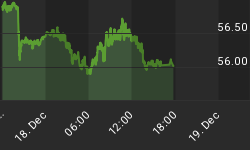Below is an extract from a commentary originally posted at www.speculative-investor.com on 5th January 2006.
We are extremely bullish on gold's long-term prospects and as a direct result of this view the TSI Stocks List is dominated by highly-leveraged gold stocks, as is our own investment portfolio. But despite our long-term bullish outlook the big run-up in the prices of gold and gold stocks that occurred during the final four months of last year took us by surprise. It took us by surprise because monetary conditions in the US were not supportive of such an outcome.
One of the reasons gold did well during 2005 in terms of all the major fiat currencies, even though monetary conditions became somewhat tighter in the US, is that liquidity remained abundant throughout the financial world. What we've seen, in effect, is all boats being pushed higher by a rising tide of liquidity, with the relatively under-valued boats such as gold, commodities, and the Japanese stock market rising more than the relatively over-valued boats such as bonds and the US stock market. However, while gold has done well relative to the over-valued investments it has not done particularly well relative to the other under-valued investments. For example, the following charts of the gold/GYX ratio (the gold price divided by the Industrial Metals Index) and the gold/Nikkei ratio (the gold price divided by Japan's Nikkei225 Index) show that gold recently hit a 4-year LOW relative to the average industrial metal and a 3.5-year LOW relative to the Japanese stock market. Gold has performed better relative to the CRB Index, but despite the strong rebound during the final four months of last year (and the first two trading days of this year) the gold/CRB ratio is still below where it was two years ago.


Does gold's poor performance relative to some assets really matter? After all, although gold's performance during 2005 might not have been the best it was still pretty good.
In the short- and intermediate-terms it doesn't matter, but as far as our long-term outlook is concerned it sure does. We certainly wouldn't have such a strong focus on gold and gold stocks as investments if we thought that gold was simply going to keep pace with other commodities and with non-US stock markets. Why, for instance, would we want to be very overweight a controversial investment like gold -- a commodity that central banks own in huge amounts and would prefer did not rise much in price -- if we thought we could achieve similar returns by investing in blue-chip Japanese stocks or base metals?
The answer is we wouldn't. There'd be no good reason for us to focus on gold if we thought that gold was going to keep doing what it has been doing over the past 12 months relative to other, simpler, investments.
We are concentrating on gold-related investments because we expect the next few years to be a lot more like 2001-2003 than 2005. During 2001-2003 gold rose against EVERYTHING as confidence fell and US monetary policy became easier. The amount of gold owned by central banks is the equivalent of 15 years of mine supply, but this doesn't matter if confidence in central banking is on the decline and gold is attracting a monetary premium. Under such conditions the sale of gold by central banks becomes counter-productive -- assuming, that is, that the selling is being done with the aim of suppressing the gold price -- because the more gold the banks sell the 'softer' their currencies are perceived to become and the higher the gold price goes. This is why central banks are powerless to prevent the gold price from rising once the long-term confidence trend reverses course (as it did during 1999-2001).
Getting back to the relationship between gold and US monetary conditions mentioned in the top paragraph, what we saw during the second half of 2005 was gold rallying as a commodity; what we didn't see was gold rallying as a form of money. In fact, the performance of gold relative to most other metals indicates that gold's monetary premium peaked during the second half of 2003 and has since been shrinking.
Not coincidentally, the above chart of the gold/GYX ratio looks very similar to the below chart of the US yield-spread (in this case we've used the TYX/FVX ratio -- the yield on a 30-year T-Bond divided by the yield on a 5-year T-Note -- to represent the yield-spread). The message is that gold's monetary premium expanded -- resulting in gold becoming a relatively strong metal -- as the US yield-spread widened, and then contracted -- resulting in gold becoming a relatively weak metal -- as the US yield-spread contracted. Our view is that gold will again become a relatively strong metal following the next major trend reversal in the US yield-spread. This, we think, will happen by the middle of 2006.

















